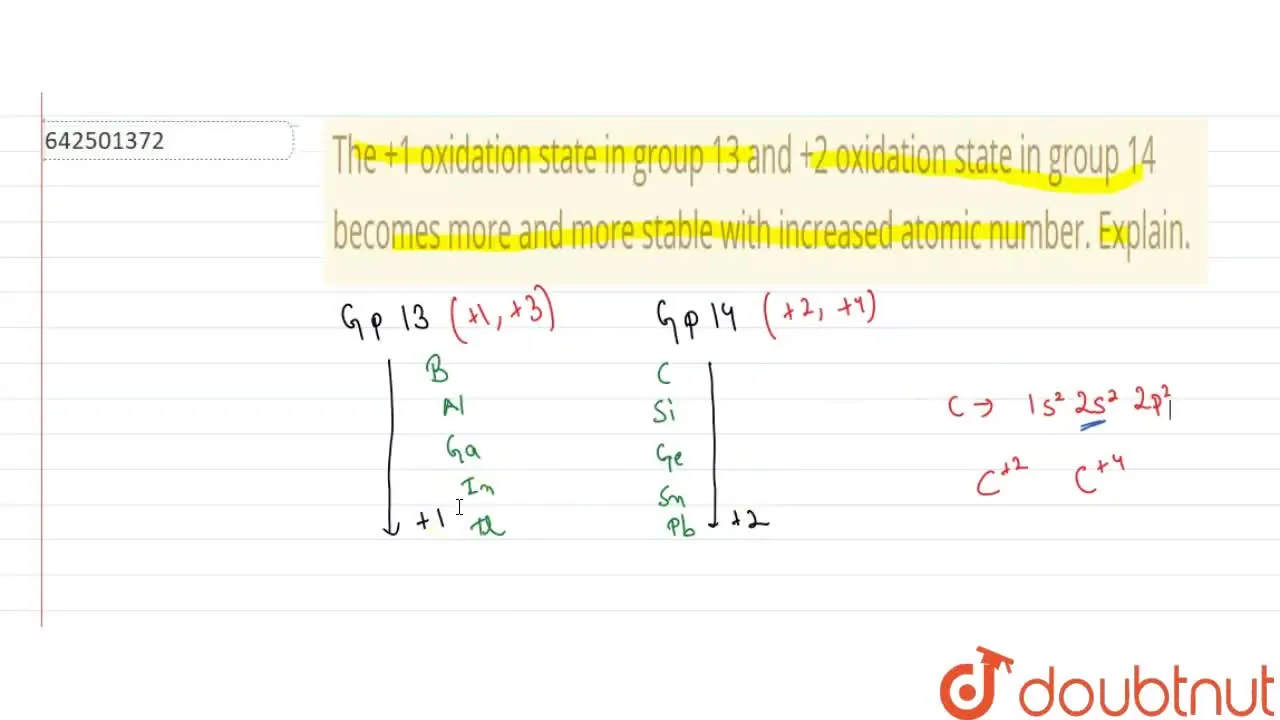The +1 oxidation state in group 13 and +2 oxidation state in group 14 becomes more and more stable with increased atomic number. Explain.
The term inert pair effect is often used in relation to the increasing stability of oxidation states that are 2 less than the group valency for the heavier elements of groups 13,14,15 and 16. in group 13 all the elements show +3 oxidation state whereas Ga, In and Tl show +1 oxidation state also
Boron, being small in size can lose its valence electrons to form B3+ ions and shows +3 oxidation state
+1 oxidation state of Tl, Ga is due to inert pair effect. The outer shell s-electrons (ns2) penetrate to (n-1) d-electrons and thus becomes closer to nucleus and are more effectively pulled towards the nucleus
The results in less availability of ns2 electrons pair for bonding or ns2 electron pair becomes inert. This reluctance in the participation of ns2 electrons in bonding is termed as inert pair effect. The inert pair is more effective after n≥4 and increases with incresing value of n. For groups 14, in spite of four valence electrons, they do not form M4+ or M4− ionic compounds. They form covalent compounds with four bonds.
Ge,Sn and Pb also exhibit +2 oxidation state due to inert pair effect Sn2+andPb2+ show ionic nature. The tendency to form +2 ionic state increases on moving down the group due to inert pair effect.
Related Playlists
- BOOK - NCERT EXEMPLAR ENGLISHCHAPTER - THE P-BLOCK ELEMENTSEXERCISE - Matching3videos
THE P-BLOCK ELEMENTS
- BOOK - NCERT EXEMPLAR ENGLISHCHAPTER - THE P-BLOCK ELEMENTSEXERCISE - Assertion and Reason2videos
THE P-BLOCK ELEMENTS
- BOOK - NCERT EXEMPLAR ENGLISHCHAPTER - THE P-BLOCK ELEMENTSEXERCISE - Long Answer9videos
THE P-BLOCK ELEMENTS
- BOOK - NCERT EXEMPLAR ENGLISHCHAPTER - STRUCTURE OF ATOMEXERCISE - All Questions55videos
STRUCTURE OF ATOM
- BOOK - NCERT EXEMPLAR ENGLISHCHAPTER - THE S-BLOCK ELEMENTS EXERCISE - Long Answer Type Questions8videos
THE S-BLOCK ELEMENTS
Similar Questions
The stable oxidation states of Mn are
View SolutionThe +1 oxidation state is more stable than +3 oxidation state for thallium. Give reason.
View SolutionThe +1 oxidation state is more stable than +3 oxidation state for thallium. Give reason.
View SolutionGeneral oxidation state shown by group 13 elements is
View SolutionHow does the stability of +1 and +3 oxidation states vary in group 13?
View SolutionWhat are common oxidation states of group 15 elements?
View SolutionElements of group 14 exhibit oxidation state of
View SolutionThe less stable oxidation state of Cr are:
View SolutionThe relative satbility of +1 oxidation state of group 13 elements follow the order :
View SolutionThe relative satbility of +1 oxidation state of group 13 elements follow the order :
View Solution


